Marble Arch sculpture
Marble Arch, a grand triumphal arch in Imperial Roman style, which has lost much of its grandeur due to the traffic sweeping by, was originally designed as an entrance to Buckingham Palace in the 1820s. It is built of white Carrara marble, which cost £80,000 at the time of building. It bears significant architectural sculpture, also in white marble, and has lost rather more. It remains as one of the dozen or so iconic sculptural works in London.
What we see today is the blocky arch, with taller central entrance, and lower side doors, separated by four Corinthian pillars. Each arch has two spandrels above it (the roughly triangular spaces between a rounded arch and the corner of a rectangle) bearing sculpture in relief of winged Victories, and above each of the lower side doors is a square panel with further sculpture. The arrangement is duplicated on the other side, so we have 12 spandrels and four square panels in all, and eight Corinthian pillars. Above, there is an attic stage, blank of any sculptural adornment, for reasons we shall see, and above each pillar a series of mouldings projecting from the flat top of the monument. The sides of Marble Arch are blank, except for three carved wreaths, high up.
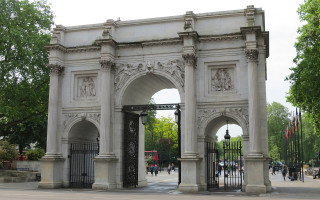 Marble Arch, north side (to Oxford Street).
Marble Arch, north side (to Oxford Street).
John Nash, famous for the Nash terraces of Regent’s Park and much else, was the architect, working in the 1820s, and in 1825 he gave to the sculptor John Flaxman the task of designing the sculptural adornment. His concept was essentially as we see the Arch today, but with much more at the top: there were attic friezes, free-standing figures above the pillars (winged Victories), a central raised plinth bearing a group of Britannia with a portrait of Nelson, and another of Europe and Asia with a portrait of Nelson – this was after all a triumphal arch as well as an entrance to the Palace. And on top of the plinth, raised above all, Flaxman envisaged an equestrian statue of George IV, monarch at the time. But Flaxman died in the following year, and Nash had to find other sculptors to complete the sculpture, working to Flaxman’s overall design. Sir Richard Westmacott RA, sculptor of the enormous Achilles (Wellington Memorial) in Hyde park (see this page) among other things, E.J.Baily, Flaxman’s assistant and a notable portrait sculptor, and J.C.F. Rossi, were chosen as the sculptors, and Francis Chantrey, most industrious of all early 19th Century sculptors, was commissioned to make the equestrian George IV.
Then in 1830 George IV died, Edward Blore became the new architect for Buckingham Palace, and decided that the upper tier friezes, which were scenes of battle on sea and land, should be used on the Palace itself, facing the gardens. He also felt that the upper, standing figures of the winged Victories and so forth should not be on the arch, and also opposed the equestrian statue of George IV for the top. Fortuitously, the National Gallery building in Trafalgar Square was being completed at the time, and the architect, William Wilkins, was presented with the extraneous statues. With a bit of modification, he was able to use them, and Baily’s winged Victories and Rossi’s charming Europe and Asia groups can still be seen in the niches on the frontage of the gallery to Trafalgar Square. Round the National Portrait Gallery side is Baily’s Britannia, with shield modified and trident converted to become a Minerva. Chantrey, who had managed to get agreement to making his figure of George IV larger than originally envisaged, completed his equestrian statue, which now stands in Trafalgar Square itself.
Statuary removed to the National Gallery: Minerva, Victories, Asia.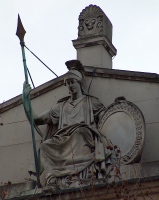
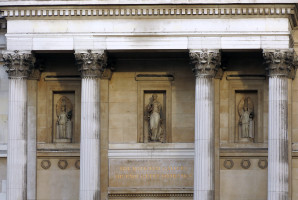
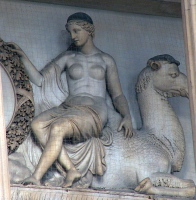
Marble Arch did not long stay at Buckingham Palace, and in 1851 was moved to become the western entrance to Hyde Park. Various road changes, most recently in the 1960s, have left the Arch on a giant traffic island, surrounded by cars and concrete.
Let us look more closely at what is left on the Arch itself.
The north side, thus facing Marble Arch tube across the end of Oxford Street, is Sir Richard Westmacott RA’s side. The two panels are his, and as he did half of the spandrel figures, we can assume that these are the ones on the north side too. The one panel has three standing female figures, who are England with Scotland and Wales. England is central of course, wearing long drapes, and with a Corinthian helmet, and with her shield tucked behind her; we cannot see her arms as her companions press close. To the left as we look at the group is the statue of Wales, wearing a light off the shoulder garment leaving her visible arm bare, her hand resting on a tall harp – note also the trefoil leaves in her hair. She is looking towards England. To the right is the figure of Scotland, with her shield bearing the cross of St Andrew, and with her back to the viewer, and with an elegant twist to her spine so that she looks over her shoulder to the centre; her hair, curling over her neck and shoulder, has thistles within it. The group overall is certainly in a Flaxman type composition, though the drapery Westmacott has chosen is more Roman than the cleaner Hellenic lines Flaxman would have used.
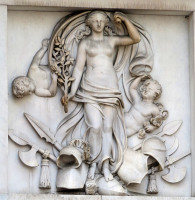
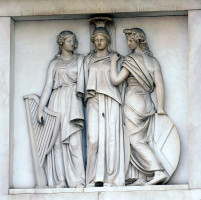 Westmacott's two sculptured panels, north side of Marble Arch.
Westmacott's two sculptured panels, north side of Marble Arch.
Westmacott’s second panel is Peace and the Trophies of War, or as stated in some contemporary accounts, The Genius of England inciting Youth. We see an almost nude girl standing facing the viewer, surrounded by a sweep of drapery which comes forward around her hip and lightly covers her legs. She holds the end of the drape with one hand, and a slender branch of olive in the other. She stands on an architectural triumph, which is to say a group of crossed weapons, with helmets and other bits of armour. To her left and right, appearing from behind her and the drapes, are plump putti or cherubic figures, one holding roses. It is these figures which suggest the Youths who are being incited by the Genius of England – the central figure is plausible as an allegory of Genius, whom we would expect to be nude, and whose fruiting branch could be the ideas being put forth by her inspired thought. Peace and the Trophies of War is equally plausible as Peace may well carry an olive branch, and she is standing on a trophy. The latter attribution fits better with a triumphal arch. Regardless, a very fine composition based on the round, and the elegant, femininely curved nude is most poetically conceived.
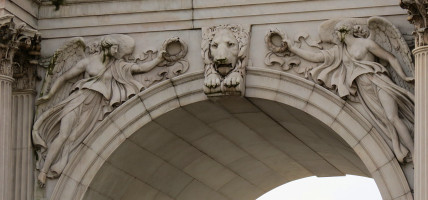 Central spandrel angels and lion head, north side.
Central spandrel angels and lion head, north side.
The spandrel angels of Victory are also excellent creatures. The two pairs over the side arches are to all intents and purposes replicas of each other, though within each pair there are variations on each side in the drapery, while those over the central arch are larger and differ in pose. The drapery is much undercut and extremely folded, a trait of Westmacott’s other angels which I have seen. Each is more draped on the side towards the arch, thus with one breast, shoulder and leg bare (those above the central arch are more covered); the forward arms hold wreaths, and underneath them are twining ribbons. The lower arches have as their keystones heads of warriors, wearing Greek helms pushed back in the manner of statues of Athena; the central arch has as its keystone a splendid carving of the head of a lion, most sombre, with its clawed feet protruding from under its mane (lots more examples of lion heads on this page).
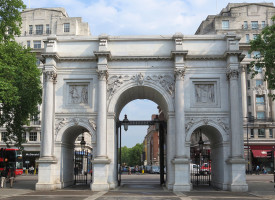 Marble Arch, south side (to the Park).
Marble Arch, south side (to the Park).
The south side, seen from the central reservation, is Baily’s side. His panels are Peace and Plenty, and Valour and Virtue, each with a pair of figures. Peace and Plenty shows two tall female figures, one a winged angel with arm raised in a gesture of benediction, the other a girl holding an olive branch (for Peace<) and a tall cornucopia (symbolising Plenty). Between them is a renaissance table holding a flaming torch in low relief.
E.J. Baily's two panels, south side of Marble Arch.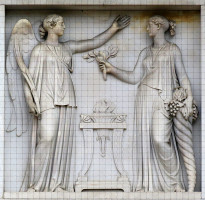
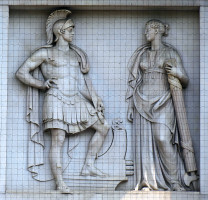
By contrast, Valour and Virtue consists of a male and female figure. Valour is a Roman soldier, muscular and bare chested, with crested helmet, cloak, kilt, and holding a sword. He stands with one foot raised on what seems to be the prow of a ship. Virtue is of course fully dressed, a Vestal Virgin of a figure, with long robes, and holding clustered sticks around an axe.
Baily’s spandrel angels have the same wreaths and general pose as Westmacott’s, but their wings are posed differently, with the rear ones forward into the narrow centres of the spandrels, and less variety of pose. The drapery is somewhat scantier, so the visible leg of each angel is exposed up to the thigh, and the upper garment a single pleated piece of fabric over one shoulder. While muscular of shoulder and arm, Baily’s angels are more rounded and slender of neck and leg than Westmacott’s. (Lots more spandrel sculpture on this page.) The central keystone of each arch is decorated with a bearded male head (and for lots of bearded male keystone heads see this page).
Eastwards - Oxford Street // South along Park Lane to the Byron Statue // and thence to Hyde Park Corner
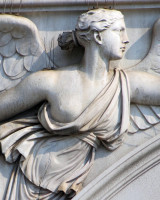
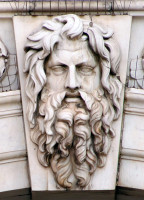
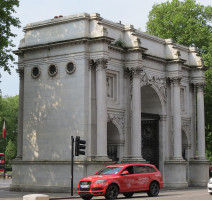
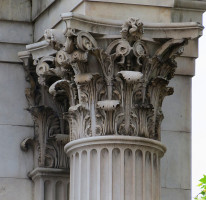
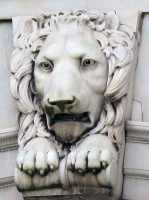
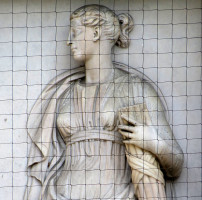
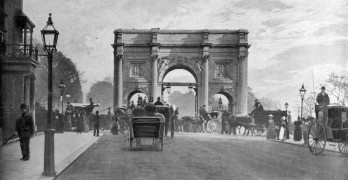 Marble Arch, ca.1900.
Marble Arch, ca.1900.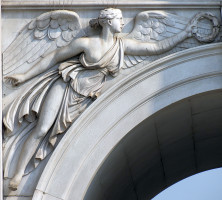
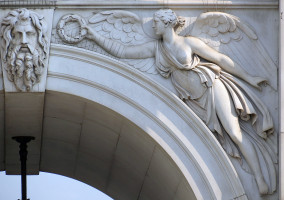 Spandrel angels by E.J.Baily.
Spandrel angels by E.J.Baily.